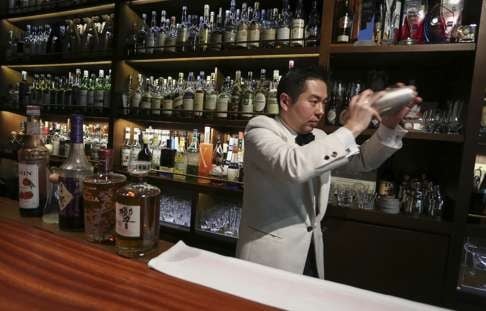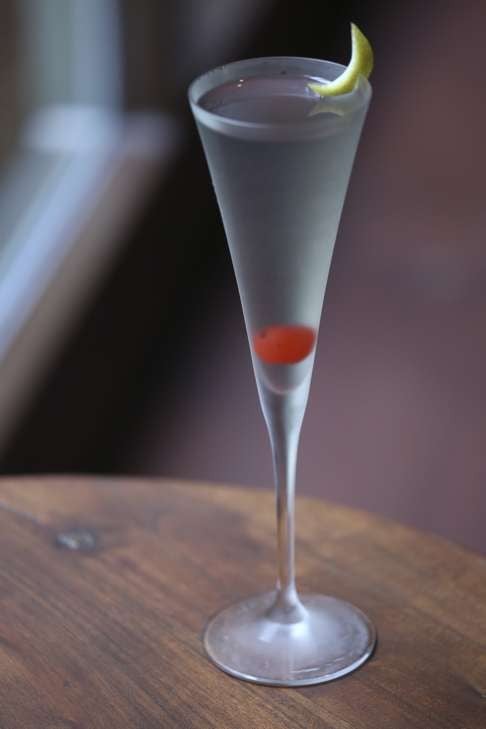
Hong Kong’s Japanese bartenders talk about ice and the hard shake
Masahiko Endo, Ichiro Hiidome and Hidetsugu Ueno of Tokyo’s Bar High Five – in town for a pop-up bar – share their passion and a few tricks of the trade
Conjure an image of a Japanese bartender in your mind, and you’ll likely think of a person who is immaculately presented, polite and works with meticulous precision.
“The philosophy is called omotenashi,” says Masahiko Endo, bartender-in-chief at Mizunara: The Library. The word, meaning hospitality, encompasses the unique form of politeness and respect for which the Japanese are known. “The most obvious example is in sado, the tea ceremony,” says Endo. “The guest and the host respect and appreciate each other.”

Hidetsugu Ueno, master bartender of Bar High Five in Tokyo, adds: “Japanese bartenders are conscious that they are being watched. Our posture and how we move must be elegant, as it influences the customer’s experience.”
Ueno will host a pop-up at MO Bar at Landmark Mandarin Oriental, Hong Kong until the end of October.
“We care about the small details,” Ueno adds. For example, when he gives customers a glass of water, he puts a small cube of ice in, which he says tells him when the customer has finished the water (“there’s a clink”).
Ice and water are central to any bartender’s work. Ueno elaborates: “One quarter of the drink is water, so the quality of the water in the ice actually determines the taste of the cocktail.”

“If it tastes watery, it’s because it wasn’t mixed well. Think of it as mayonnaise. It’s an emulsion; the egg and oil should not be separate.”
Many Japanese bartenders make their own ice, and it could take up to four days to make a perfect, crystal clear, airless block, which is cut down into smaller cubes.
It’s believed that these slowly formed blocks of ice won’t melt as easily. “If you order whisky on the rocks, you want to taste the whisky, not the water,” says Hiidome, who uses a special alkaline ionising filter for his water for a “smoother” texture.
Hand forming ice into cubesand various other shapes with ice picks and knivesis a key part of a Japanese bartender’s repertoire.
Hiidome creates heart-shaped ice for couples on dates, and Ueno is known by bar enthusiasts for his “ice diamond”, but ice is also vital in another technique, the hard shake.
Endo says that the technique, for which Japanese bartenders are known, aerates the drink, making it more gentle on the palate. Always done in a cobbler shaker, a three-piece shaker with a cup, strainer and small cap, it tends to be a series of fluid, elegant moves, designed to minimise large cracks in the ice cubes,and instead, create small shards that end up floating on top of the beverage.
“It’s a softer touch, and the drink is smooth and easy to drink. At the beginning [when the technique was first used], people said it was wrong, but now it’s become one of the special ways Japanese bartenders use to make cocktails,” he says.

The differences don’t end there. Ueno’s service style is playful, often joking and chatting with customers, bucking the “quiet bartender” image, and he wears his hair like Elvis, while Endo insists on a formal ivory jacket, tuxedo shirt and black bow tie, and makes his cocktails in complete silence.


“I’ve tried fruits from other countries, but in my opinion, Japanese fruits have good flavour and aroma. I never add syrup to the fruit drinks, and with Japanese fruits, I never need to.”
While Endo feels his training has mostly been in the classic styles, his signature drinks are all new creations, born out of participation in cocktail competitions. Coming from Fukuoka in southern Japan, far from the epicentres of Japanese bartending of Yokohama and Tokyo, made him more curious about what was happening in the rest of the country.
“Competitions help because they let me know where I am compared to the best in the country,” he says. Now that he’s in Hong Kong, he doesn’t compete, but continues to create new drinks every day.


Whatever techniques they use, Japanese bartenders always go back to what is important: the customer’s enjoyment.
“When a guest comes into the bar, it should be like stepping into another world. They can forget their normal life. They should feel happy and comfortable,” says Endo.
Bar High Five pop-up until October 31
The Shell at MO Bar, The Landmark Mandarin Oriental, The Landmark, 15 Queen’s Road Central, Central,tel: 2132 0077
Mizunara: The Library
4/F Kiu Yin Commercial Building, 361-363 Lockhart Road, Wan Chai, tel: 3571 9797
b.a.r. Executive Bar
27/F Bartlock Centre, 3 Yiu Wa Street, Causeway Bay, tel: 2893 2080
Butler
5/F Mody House, 30 Mody Road, Tsim Sha Tsui, tel: 2724 3828

